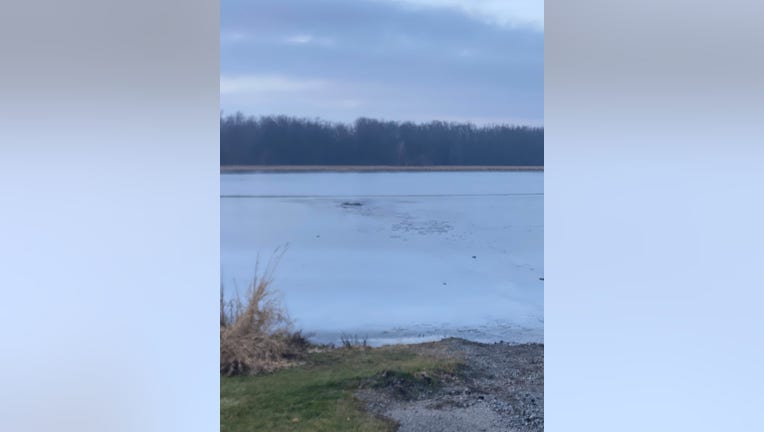Man, DNR conservation officer treated for hypothermia after ice rescue on Michigan lake

NEWAYGO COUNTY, Mich. (FOX 2) - A Department of Natural Resources conservation officer and a man both needed treatment for hypothermia after the man fell through ice on a Michigan lake.
The 21-year-old Grant man was walking on Blanche Lake in Newaygo County, north of Grand Rapids, when he went through the ice Sunday afternoon.
Conservation Officers Jeff Ginn and Tim Barboza and probationary Conservation Officer Brandon Benedict responded to the lake and found the man in water where depths range from 15-20 feet.
Ginn put on a personal flotation device and crawled on the ice, about 50-75 yards from shore, where the man was clinging to the edge of the ice about an inch thick. The man displayed signs of hypothermia and was too weak to swim, the DNR said.
"When I was about 10 feet from the man, I threw him a personal floatation device and a rescue rope," Ginn said. "He was unable to hold the PFD because he was holding onto the ice shelf."

CO Jeffery GinnConservation Officer Portraits in 2017
The officers attempted several ice rescue methods, including tossing the man a throw rope and ice picks.
"He was unable to wrap the rope around himself because he did not want to let go of the ice," Ginn said. "I threw him ice spikes, but he couldn’t reach them."
The DNR said Ginn was using an off-road vehicle ramp for weight distribution, and used the ramp to push the ice picks closer to the man.
"Water began to flood the surface of the ice, then broke underneath me, causing me to enter the water," Ginn said. "Once in the water, I swam to and grabbed ahold of him. I grabbed the PFD I previously threw to him had him hold it to his chest, then grabbed the rope and ice spikes and swam us to the edge of the ice. I used the ice spikes to hold us against the ice shelf and attempted to tie the rope around his body under his arms."
Barboza crawled on the ice to tie a rope through Ginn’s flotation device, and additional ropes were tied to the original line, which emergency responders used to try and pull the men from the water. However, the ice continued to break.
Ginn was eventually pulled from the water but jumped back in to keep the man from sinking.
"I knew we were going to be in the water for a while, and kept talking to the man to keep him alert," Ginn said. "I knew if I let go, he’d sink."
Newaygo Fire Department personnel in cold-water survival suits used an inflatable raft to get the man out of the water, while Ginn climbed onto the ice and was pulled to shore with a rope.
Read more stories from around Michigan here.
The man, who was in the water for more than 30 minutes, had a body temperature of 87 degrees. Ginn's temperature was 89 degrees after about 20 minutes in the water. A body temperature below 95 is considered hypothermia. Both were taken to hospitals and have since been released.
"The department is beyond grateful that one of our conservation officers and a young man are both doing well after spending an extended amount of time in the cold water," said Chief Dave Shaw, DNR Law Enforcement Division.
The DNR is using this rescue to remind people to be careful on ice.
"As anxious as we all are to enjoy our favorite winter activities, the unseasonable winter has created unstable ice conditions throughout much of the state, particularly the Lower Peninsula," Shaw said. "Everyone should use extreme caution when on or near the ice, consider wearing a personal floatation device and have ice picks easily accessible. There is no such thing as safe ice."
If you see someone go through the ice, call 911.
If you'll be on the ice, the DNR has some safety tips and facts about ice:
- Your safety is your responsibility! There is not a reliable "inch-thickness" to determine if ice is safe.
- You can test ice thickness and quality using a spud, needle bar, or auger.
- Strongest ice: clear with bluish tint.
- Weak ice: ice formed by melted and refrozen snow. Appears milky.
- Stay off ice with slush on top. Slush ice is only half as strong as clear ice and indicates the ice is not freezing from the bottom.
- A sudden cold front with low temperatures can create cracks within a half-day.
- A warm spell may take several days to weaken ice, and cause the ice to thaw during the day and refreeze at night.
- Ice weakens with age.
- If there’s ice on the lake but water around the shoreline, be extra cautious.
- Stronger the current on the lake, the more likely the ice will give to open water.
- Avoid areas of ice with protruding debris like logs or brush.
- Keep an eye out for dock bubblers or de-icers as the ice near these mechanisms will be unsafe. Always check the ice and be aware of your surroundings.
For more safety information and tools you should bring with you on the ice, click here.

